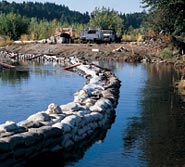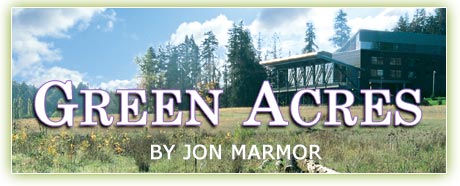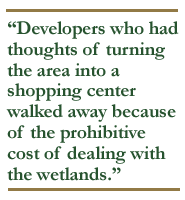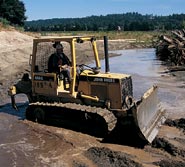
Sandbags mark the new meandering channel of North Creek that was cut into the former pastureland. Photo courtesy Lyndon C. Lee & Associates.

The grading took more than a year as contractors reconnected the creek to its flood plain by reconstructing a meandering channel system that would provide natural hiding and feeding places for fish and other animals. Once that was done, workers dug small ponds called microdepressions to act as natural filters for water that drained from higher elevations. This would siphon off energy released by rushing waters during heavy rains and add a natural filtering system to remove silt and other contaminants from the water. Theyalso added features such as small hilly areas to serve deer and other wildlife.

Once the area was free of invasive reed canary grass, Himalayan blackberry and purple loosestrife, workers planted native vegetation such as Douglas fir, red cedar and other trees (much of it grown at a nursery on the wetlands site). By the turn of the century -- these baby trees will grow into a thick forest. That should kill off the pesky reed canary grass with a canopy of shade, while providing a natural barrier between the land and the freeway.
A 10-year monitoring project began in spring 2002 to make sure the area meets city, county, state and federal water and air quality standards, and that the non-native weeds are not regaining their footing.
Another measure of progress is the number of wildlife species returning to the wetlands. Sockeye, Chinook and wild King salmon and steelhead once again make North Creek their home. And the number of bird species spotted has grown significantly. Dozens of species, from the common barn swallow to the rarely seen dark-eyed junco can be found in the wetlands, according to Jennifer Leach, a UW Bothell senior who studies birds.
"Birds are finding their way to the site and using it in varying capacities throughout the year," she says. "The site seems to be providing wintering habitat for several species, others bred there this year, and still others seem to use the site as a stopping place during their spring or fall migrations."

Researching how well wetlands transformation works was one of several goals of a 1999 Tools for Transformation grant headed by Warren Gold, a UWB professor of plant ecology and environmental science.
One plan is to make the wetlands into an educational resource by creating a "Walk Through Washington" trail. The idea is to turn the historic Chase House - the home of Dr. Reuben Chase, the first doctor in Bothell, which is on the UWB property - into a research station and interpretive center. A trail would lead out through the tall grasslands of the buffer zone between campus buildings and the wetlands into areas planted with trees and vegetation from different parts of the state.

"We have an unparalleled resource here," Gold says. "We are fortunate that we have the opportunity here to reclaim this land. This is quite rare for an urbanized area like this one."
"As the area gets developed," says Dan Jaffe, a UWB chemistry professor who is part of the Tools for Transformation project and monitors air and water quality in the wetlands, "it puts more challenges on the streams and fish. Snohomish County is becoming an increasingly urbanized area. Can we hang onto the nature we have there and preserve it? That is the challenge."
—Jon Marmor, '94, is associate editor of Columns.
Go To: Page 1 | Page 2 | Page 3